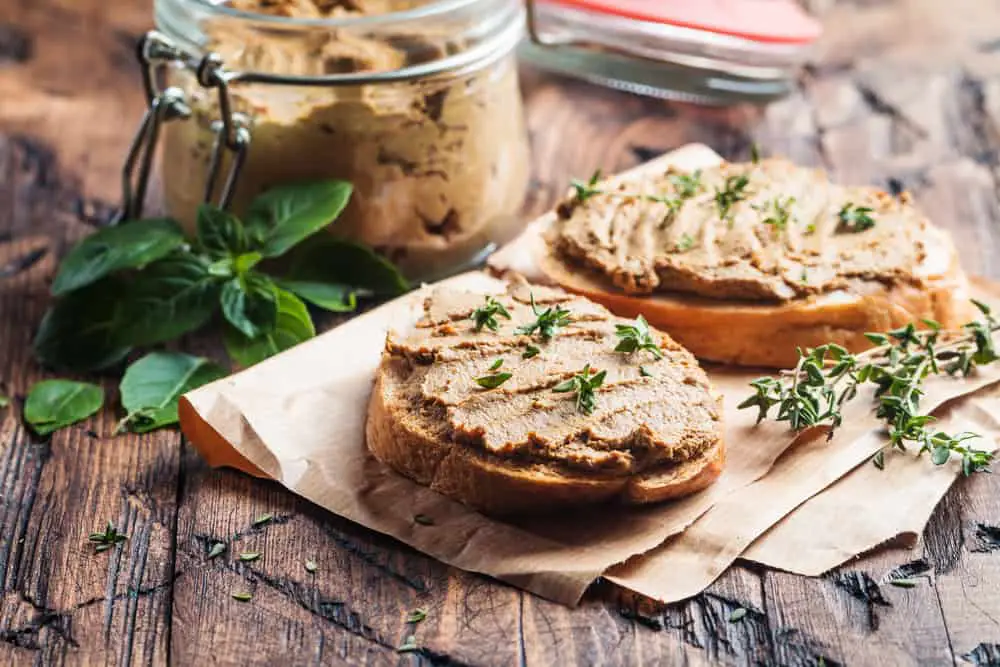Last Updated on 20th July 2022 by
Pâté, like caviar, is a dish people often associate with affluence. It’s one of those elegant-sounding French hors d’oeuvres that is a staple in most artsy charcuteries. Though quite popular, many people are clueless about what Pâté is.
So, what is a Pâté made of? How do you make a Pâté? How long does Pâté last? These questions will be answered as you read on.
What is Pâté?
So, what is Pâté, and why is everyone raving about it? Literally, Pâté means “paste” or coarse mixture in French. This brown mush traces its origin in northern and central European cuisines.
As classy as it sounds, Pâté is actually a mixture of seasoned ground meat, fat, seafood, poultry, vegetables, and savory herbs and spices.
Traditionally, it is served baked on a crust (en croûte) or molded as a terrine. Did you know that the crust of the en croûte form was not originally intended to be eaten? You read it right. The original purpose of the crust was to hold the pâté together. Interesting, isn’t it?
What is the Difference Between Pâté and Terrine
In French cuisine today, the terms Pâté and terrine are interchangeably used due to a similarity in basic recipes. A Pâté is usually made in a porcelain dish called a terrine – which is how it got its name. Some people consider terrine to be a coarser version of Pâté.
Let’s talk about Pâté and terrine in detail. Terrine is a dish made from ground meat, seafood, organ meat, boiled eggs, vegetables, herbs, and other seasonings that are layered in a steel or ceramic, loaf-shaped mold. The layered mixture is then cooked in a water bath, cooled, and served as slices.
On the other hand, Pâté is simply a fine or coarse blend of ground meat, herbs, organs, vegetables, or seasonings. It may contain milk for a smoother texture or eggs to help it set in the mold. Most commonly, Pâté forms a layer in the making of terrine– it may even be as simple as a chicken liver mousse.
How To Make Pâté
Now, this is how to make Pâté. Depending on the style, methods of preparing the Pâté vary. Most recipes start by hand-chopping the meat, which is less likely to damage the meat’s existing fat cells. Using a meat grinder is also an alternative.
Once the meat is prepped, it is mixed with flavorings (such as herbs, spices, garlic, sautéed shallots, wine, cognac, or brandy). In some recipes, the mixture will include a panade (a paste made of bread, flour, or rice) or a beaten egg to help bind the meat together.
When the meat mix is complete, it is then transferred to a terrine lined with sheets of fatback or bacon and cooked in the oven in a water bath (bain-marie) or sous vide, using an immersion circulator.
Once the meat mixture is complete, it’s then transferred to a terrine lined with sheets of fatback or bacon and cooked in the oven in a water bath (bain-marie) or sous vide, using an immersion circulator for fancier kitchens.
It’s pretty simple, right?
How To Eat Pâté
This famous spreadable food may be smooth and creamy in form or may be on the chunky side. A decadent Pâté is considered great. It may be served hot or cold, molded or unmolded. But if you want to get the best taste, it is advised to chill it for a few days before consuming it.
You may be wondering how to eat Pâté and how to serve it. Well, Pâté is quite versatile.
You can serve it on bread or as part of a charcuterie board with mustard, jam, pickled vegetables, or a plain vinegary green salad. It can be served as an appetizer (with a vinegary green salad) or spread on sourdough bread for lunch. Fresh baguette, sliced toasted baguette, or crackers works very well with Pâté.
How Long Does Pâté Last?
How long does Pâté last, you ask? Pâté, especially ones made from scratch, doesn’t stay for long and must be consumed immediately. It will remain fresh for about a week when kept in the fridge. Store-bought unopened pate can be stored for about two weeks. If you want to stretch the shelf life of pate to up to 3 months or more, keep it in the freezer.
How To Make Liver Pâté?
Did you know that the most famous Pâté is “pâté de foie gras”, made from the livers of fattened geese and is unusually expensive? Its estimated price per pound is around $50!
If you want to make a Pâté from scratch, you can try this recipe on how to make liver Pâté below. It may sound classy, but surprisingly, it’s inexpensive and easy to make.
Ingredients:
- 6 tablespoons of unsalted butter, divided
- 1/3 cup minced shallot
- 1 pound of chicken liver
- Salt
- One clove of garlic, minced
- 2 tablespoons capers
- 1 teaspoon of dried thyme
- 1 teaspoon anchovy paste, optional
- 1/4 cup brandy
- 1/4 cup cream
Directions:
- Trim any fat or connective tissue from the chicken livers and put them away.
- In a large sauté pan, heat two tablespoons of butter on medium heat until it’s slightly brown for about 3 to 5 minutes.
- Next, add the shallots and sauté for one minute. Then, add the livers. Make sure to space them well in the pan so they can brown more quickly. Sprinkle salt over the livers. When one side browns, don’t forget to flip the livers.
- Add the capers, thyme, garlic, and anchovy paste (to your preference) once the livers have browned and sauté for another minute.
- Take the pan off the heat and add the brandy. Increase the heat to high, let the brandy boil, reduce it to the consistency of syrup, and allow the mixture to cool.
- Have the mixture food processor or blender and pulse a few times to combine. You may add the remaining butter and the cream and purée. The mixture will look a little loose, but it will firm up in the fridge.
- Pack the Pâté into ramekins or a small bowl. Cover and refrigerate for at least an hour before consuming.
Serve with thinly sliced brown bread, crackers, or a baguette slice. Happy eating!
I'm Pauline, a mother of four grown children, my passion for cooking stemmed from the joy i get cooking for my family. I love to try new dishes, especially when dining out but creating and sharing my own recipes is my favourite thing to do!



Binance代码
Sunday 2nd of March 2025
Thanks for sharing. I read many of your blog posts, cool, your blog is very good.
pronunciations
Friday 21st of February 2025
fNjr4vGuOH8